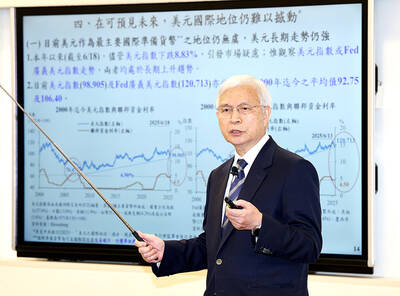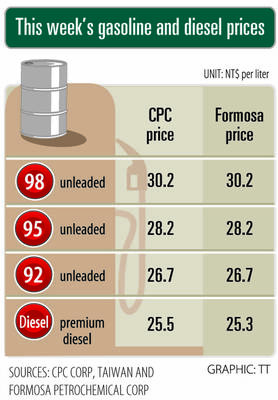Epistar Corp (晶電), in a historic shift in the 21-year-old company’s history, announced that it plans to spin off two of its three main business units by the end of this year.
The company, which is one of the nation’s leading suppliers of LED epitaxial wafers and chips, said that the restructuring is mainly motivated by large potential growth in new LED applications and III-V compound semiconductors — compounds made using elements listed in columns III and V of the periodic table.
The move is in line with a strategy to diversify its businesses and would maximize returns for both shareholders and investors, Epistar president M.J. Chou (周銘俊) said.
The Hsinchu-based company announced the spin-off plan at an investors’ conference on Wednesday last week.
Under the plan, Epistar would spin off a unit that makes epitaxial wafers for vertical-cavity surface-emitting lasers (VCSEL) and gallium nitride chips, Chou said.
It would also spin off a unit that produces chip-scale packaging LEDs, mini and micro-LEDs, sensing devices and III-V compound semiconductor-based solar cells used in satellites, he said.
Epistar itself would focus on manufacturing aluminum gallium arsenide, which is used for producing high-brightness red and infrared LEDs, blue-light LEDs and diode laser systems for medical purposes, he added.
The company’s board of directors has approved the plans and the restructuring should be completed within the next six months, Chou said.
The two spin-offs might go public in 2021 or 2022 after securing strategic investors, Epistar chairman Lee Biing-jye (李秉傑) said.
“We do not expect any financial impact from the restructuring as the company would still wholly own the two spin-offs in the initial period,” Taishin Securities Investment Advisory Co (台新投顧) analyst Wong Ting-wei (翁廷維) said in a client note on Thursday.
Epistar has been focusing more on the VCSEL business, as well as on mini and micro-LEDs, in light of growing pricing pressure on blue-light and infrared LED chips from Chinese rivals, the company said, but added that contributions from these new businesses would likely be limited this year.
In the first quarter, consolidated revenue fell 10.2 percent year-on-year to NT$5.15 billion (US$171.98 million), and gross margin contracted by 2.5 percentage points from a year earlier to 17.2 percent due to the slow seasonal effect and the declining average prices of blue-light products.
However, thanks to a one-off tax benefit of NT$271 million, net profit was NT$400 million last quarter, compared with a net loss of NT$281 million a year earlier, with earnings per share of NT$0.37.
The business would remain under pressure this quarter, as a supply glut continues and major clients work to adjust inventories, SinoPac Securities Investment Service Co (永豐投顧) said in a note on Thursday.
SinoPac forecast revenue to increase 19.2 percent this quarter from last quarter, but gross margin could fall to 16.8 percent due to falling average prices, while net profit is to decline 73 percent quarter-on-quarter, with earnings per share of NT$0.1.
“Overall, we expect the company to benefit from the depletion of excessive inventory by clients and the launch of new mini-LED products in the second half of this year, with the second quarter likely to be the trough this year,” SinoPac analyst Liao Kuan-chieh (廖貫捷) said in the note.

NOT JUSTIFIED: The bank’s governor said there would only be a rate cut if inflation falls below 1.5% and economic conditions deteriorate, which have not been detected The central bank yesterday kept its key interest rates unchanged for a fifth consecutive quarter, aligning with market expectations, while slightly lowering its inflation outlook amid signs of cooling price pressures. The move came after the US Federal Reserve held rates steady overnight, despite pressure from US President Donald Trump to cut borrowing costs. Central bank board members unanimously voted to maintain the discount rate at 2 percent, the secured loan rate at 2.375 percent and the overnight lending rate at 4.25 percent. “We consider the policy decision appropriate, although it suggests tightening leaning after factoring in slackening inflation and stable GDP growth,”

DIVIDED VIEWS: Although the Fed agreed on holding rates steady, some officials see no rate cuts for this year, while 10 policymakers foresee two or more cuts There are a lot of unknowns about the outlook for the economy and interest rates, but US Federal Reserve Chair Jerome Powell signaled at least one thing seems certain: Higher prices are coming. Fed policymakers voted unanimously to hold interest rates steady at a range of 4.25 percent to 4.50 percent for a fourth straight meeting on Wednesday, as they await clarity on whether tariffs would leave a one-time or more lasting mark on inflation. Powell said it is still unclear how much of the bill would fall on the shoulders of consumers, but he expects to learn more about tariffs

Greek tourism student Katerina quit within a month of starting work at a five-star hotel in Halkidiki, one of the country’s top destinations, because she said conditions were so dire. Beyond the bad pay, the 22-year-old said that her working and living conditions were “miserable and unacceptable.” Millions holiday in Greece every year, but its vital tourism industry is finding it harder and harder to recruit Greeks to look after them. “I was asked to work in any department of the hotel where there was a need, from service to cleaning,” said Katerina, a tourism and marketing student, who would

i Gasoline and diesel prices at fuel stations are this week to rise NT$0.1 per liter, as tensions in the Middle East pushed crude oil prices higher last week, CPC Corp, Taiwan (台灣中油) and Formosa Petrochemical Corp (台塑石化) said yesterday. International crude oil prices last week rose for the third consecutive week due to an escalating conflict between Israel and Iran, as the market is concerned that the situation in the Middle East might affect crude oil supply, CPC and Formosa said in separate statements. Front-month Brent crude oil futures — the international oil benchmark — rose 3.75 percent to settle at US$77.01